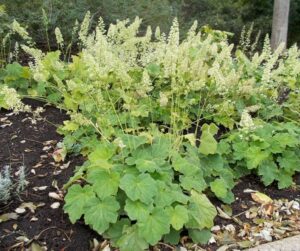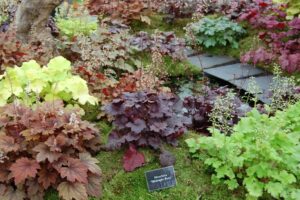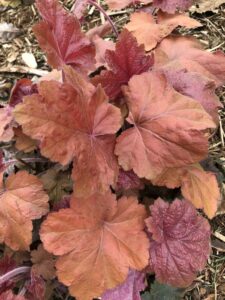Heuchera (Coral Bells, Alumroot)
go.ncsu.edu/readext?1072650
en Español / em Português
El inglés es el idioma de control de esta página. En la medida en que haya algún conflicto entre la traducción al inglés y la traducción, el inglés prevalece.
Al hacer clic en el enlace de traducción se activa un servicio de traducción gratuito para convertir la página al español. Al igual que con cualquier traducción por Internet, la conversión no es sensible al contexto y puede que no traduzca el texto en su significado original. NC State Extension no garantiza la exactitud del texto traducido. Por favor, tenga en cuenta que algunas aplicaciones y/o servicios pueden no funcionar como se espera cuando se traducen.
Português
Inglês é o idioma de controle desta página. Na medida que haja algum conflito entre o texto original em Inglês e a tradução, o Inglês prevalece.
Ao clicar no link de tradução, um serviço gratuito de tradução será ativado para converter a página para o Português. Como em qualquer tradução pela internet, a conversão não é sensivel ao contexto e pode não ocorrer a tradução para o significado orginal. O serviço de Extensão da Carolina do Norte (NC State Extension) não garante a exatidão do texto traduzido. Por favor, observe que algumas funções ou serviços podem não funcionar como esperado após a tradução.
English
English is the controlling language of this page. To the extent there is any conflict between the English text and the translation, English controls.
Clicking on the translation link activates a free translation service to convert the page to Spanish. As with any Internet translation, the conversion is not context-sensitive and may not translate the text to its original meaning. NC State Extension does not guarantee the accuracy of the translated text. Please note that some applications and/or services may not function as expected when translated.
Collapse ▲Heuchera (Coral Bells, Alumroot)
Article by Extension Master Gardener℠ volunteer Kathryn Copley
Heuchera (phonetic spelling HEW-ker-ah) has many attractive features: showy foliage (blue, brown/copper, green, pink, purple/lavender, white, or variegated, depending on the cultivar); delicate, airy flowers in pink, coral, red or white that are favored by hummingbirds, butterflies, and bees; and resistance to deer and rabbits (both of
which find the tannins in the leaves unappetizing). The common name Coral Bells comes from the plant’s bell-shaped flowers. A second common name, Alumroot, refers to the medicinal use of some of the species as an astringent to stop bleeding.
The Heuchera genus is an interesting family of more than 50 species. Depending on species and variety, they grow in zones 3 (Zone 3 plants can withstand cold temperatures of -40°F to -30°F) to 9, so selecting one that performs well in local summer heat and humidity is important.
Most plants in this genus prefer relatively dry air, but Heuchera villosa will thrive in heat and high humidity. In the South, these perennials grow best in partial shade,
preferring morning sunlight and afternoon shade. The more heat-tolerant cultivars often have Heuchera villosa in their parentage, which confers heat tolerance. Excellent cultivars known for their heat tolerance are ‘Caramel’ (peachy apricot leaves) and ‘Citronelle’ (lime green leaves). ‘Southern Comfort’ has striking leaves and thrives in hot, humid environments where other Heucheras struggle.

Heuchera villosa Form Andrey
Zharkikh CC BY 2.0 .
Heuchera’s medium growth rate and tidy, clumping form make it suitable for myriad locations: containers and hanging baskets, around a patio or pond, in a rock or shade garden, as a border, or as a mass planting. Consider combining them with ferns or hostas.
Heucheras prefer a slightly acidic pH and moist, well-drained soils. They do not tolerate heavy, poorly drained soils, so consider amending the soil with organic matter like leaf compost or pine bark fines to improve drainage. Provide weekly irrigation if the weather is hot and dry, and mulch plants with pine straw, leaves, or shredded bark to conserve soil moisture. Mulching will protect the plant’s roots in the winter months.
Heucheras are best planted in late fall or early spring. When in bloom, the plants reach 12- to 16-in. tall and should be spaced 15- to 28- in. apart or as recommended by the variety tag. They are usually short-lived perennials unless they are divided every 3 to 4 years. Deadheading the spent flowers will increase bloom production during the summer and into the fall. If leaves appear ragged, prune them and new growth will appear.
There are few insect or disease problems, but leaf scorch can be a problem for
plants grown in full sun during hot, dry conditions. Fungal diseases such as powdery mildew, rust, and bacterial leaf spot can occur. Potential insects include weevils, Japanese Beetles, mealybugs, and foliar nematodes.
Resources
- NC Extension Plant Toolbox:
- Home & Garden Information Center: Heuchera – Coral Bells
- University of Georgia: Heuchera are native to the US and an award-winning perennial plant
By Kathryn Copley, Extension Master Gardener SM Volunteer, Brunswick County, NC For more information on gardening in Brunswick County, please call the Brunswick County Cooperative Extension Office 910-253-2610





